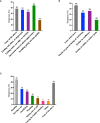How patients experience thyroid eye disease
- PMID: 38027128
- PMCID: PMC10665908
- DOI: 10.3389/fendo.2023.1283374
How patients experience thyroid eye disease
Abstract
Objective: To determine the impact of thyroid eye disease (TED) on patients in various stages of the disease.
Background: TED is a debilitating and potentially sight-threatening inflammatory autoimmune disease that is frequently misdiagnosed. Challenging quality-of-life (QoL) issues can persist long after the active phase of disease has subsided.
Methods: A 62-question survey was designed as a hypothesis-generating instrument to identify key issues confronting patients ≥18 years old with physician-diagnosed TED. Questions focused primarily on physical and emotional status, and QoL experiences in the 2 months prior to the survey. Data for individual questions are presented as summary statistics. Correlations between questions were determined using χ2 analyses.
Results: The 443 respondents were 18 to >80 years old; >90% female, and >80% from the United States. Time since TED diagnosis ranged from <1 year to >10 years. Participants provided >500 free-form responses describing experiences of living with TED. Physical signs/symptoms were experienced by 307/443 (69%) patients. Of those responding to the QoL questions (N = 394), 53 (13%) reported symptoms improving, 73 (19%) reported symptoms worsening, and 255 (65%) reported no change in the 2 months prior to the survey. The most bothersome signs/symptoms were dry/gritty eyes, light sensitivity, bulging eyes, and pressure or pain behind the eyes. Respondents <60 years were significantly (p < 0.0001) more likely to report symptomatic TED than older patients. Of 394 respondents, 179 (45%) reported feeling depressed and/or anxious, 174 (44%) reported concern about their appearance, and 73 (19%) avoided public situations; 192 (49%) reported declines in confidence or feelings of general well-being, and 78 (20%) reported an inability to achieve goals. Activities limited by TED included reading, driving, and socializing. The proportion of respondents experiencing these negative QoL measures was higher when patients reported experiencing >5 symptoms, had been diagnosed within the last 5 years, or were <60 years of age.
Conclusions: Physical manifestations of TED impact QoL for patients through all phases of the disease. It is essential that physicians and healthcare professionals become more familiar with patient experiences such as those described here to better help patients manage their disease.
Keywords: Graves’ orbitopathy; active disease; chronic disease; patient experience; patient survey; quality of life; thyroid eye disease; thyroid-associated ophthalmopathy.
Copyright © 2023 Smith, Hegedüs, Lesser, Perros, Dorris, Kinrade, Troy-Ott, Wuerth and Nori.
Conflict of interest statement
TS has been issued US patents covering the use of IGF-I receptor antagonists as therapy for autoimmune disease. These are held by UCLA/Lundquist Institute. He is a consultant for Horizon Therapeutics, Veridian Therapeutics, Inc., Minghui Pharmaceutical, and Lundbeck. LH has received honoraria from Horizon Therapeutics and Lundbeck A/S. IL has no conflicts to declare. PP has received honoraria from IBSA. KD is an employee of GDATF which has received grants from Horizon Therapeutics. MK, PT-O, LW, and MN are employees of rareLife solutions, Inc., Westport, CT, United States.
Figures









References
-
- Wang Y, Padnick-Silver L, Francis-Sedlak M, Holt RJ, Foley C, Douglas RS. Inflammatory and noninflammatory thyroid eye disease: Comparison of disease signs, symptoms, and quality of life in patients in the United States. Endocr Pract (2022) 28(9):842–6. doi: 10.1016/j.eprac.2022.06.003 - DOI - PubMed

